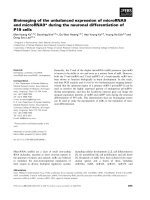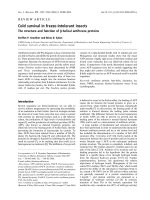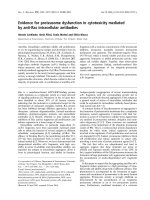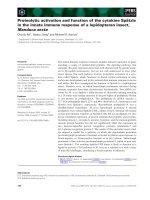Function of BPGAPI in RAS mediated neuronal differentiation
Bạn đang xem bản rút gọn của tài liệu. Xem và tải ngay bản đầy đủ của tài liệu tại đây (6.81 MB, 270 trang )
FUNCTION OF BPGAP1 IN RAS-MEDIATED NEURONAL
DIFFERENTIATION
SHARMY JENNIFER JAMES
NATIONAL UNIVERSITY OF SINGAPORE
2010
FUNCTION OF BPGAP1 IN RAS-MEDIATED NEURONAL
DIFFERENTIATION
SHARMY JENNIFER JAMES
(M.Sc. (Biochemistry), University of Madras)
A THESIS SUBMITTED
FOR THE DEGREE OF DOCTOR OF PHILOSOPHY
DEPARTMENT OF BIOLOGICAL SCIENCES
NATIONAL UNIVERSITY OF SINGAPORE
2010
i
ACKNOWLEDGEMENT
First and foremost I offer my sincerest gratitude to my supervisor, Associate Professor Low
Boon Chuan who has supported me throughout my graduate studies and thesis writing
with his constructive criticism, patience, and knowledge whilst allowing me the room to
work in my own way.
Special thanks go to Dr. Chew Li Li, Dr. Aarthi Ravichandran and Dr. Zhou Yi Ting for their
invaluable advice and time.
It is a pleasure to thank lab members past and present. I thank Dr. Jan Buschdorf, Dr. Soh
Jim Kim Unice, Dr. Zhong Dandan, Dr. Zhu Shizhen, Leow Shu Ting, Pearl Toh Pei Chern, Tan
Jee Hia Allan, Soh Fu Ling, Dr. Liu Lihui, Dr. Pan Qiurong Catherine, Chin Fei Li Jasmine,
Chew Ti Weng, Lim Gim Keat Kenny, Dr. Anjali Bansal Gupta, Archna Ravi, Shelly Kaushik,
Sun Jichao, Zhang Zhenghua, Akila Surendran, and Huang Lu who made my graduate
studies truly memorable by not only providing a lively environment but also by being
caring and helpful.
I would like to acknowledge the National University of Singapore for awarding me the
Graduate research scholarship and special thanks to my supervisor for the funding me after
the expiry of the scholarship.
My parents deserve special mention for their support, encouragement and prayers and
above all for showing me the joy of intellectual pursuit ever since I was a child and Samuel
James for being a supportive and caring sibling.
Words fail to express the appreciation for my husband Suresh for his continual support,
understanding and love. Appreciate my son David Isaac and unborn daughter Davina Isabel
for bearing with me through stressful times. Without the encouragement and sacrifice of
my family, it would have been impossible to finish this work. Last but not the least, I thank
God for his Grace, may his name always be exalted, honored, and glorified.
Sharmy Jennifer James
ii
TABLE OF CONTENTS
Pages
ACKNOWLEDGEMENTS i
TABLE OF CONTENTS ii
SUMMARY xiii
LIST OF TABLES xv
LIST OF FIGURES xvi
LIST OF ABBREVIATIONS xx
1 INTRODUCTION
1.1. Small GTPases – The molecular switches of cell dynamics control 1
1.1.1. Ras subfamily of small GTPases K-Ras, N-Ras and H-Ras 3
1.2. Mechanism of regulation and Biochemistry of GTPases control
on signaling pathway
1.2.1. Small GTPases – the binary regulatory switches of signaling 4
1.2.1.1. Regulation of GTPase activation- Role of GEFS 6
1.2.1.1.a. General Mechanism of GEFs 6
1.2.1.1.b. Conserved mechanisms in GEFS 8
1.2.1.1.c. GEFs in disease 9
1.2.1.2. Regulation of GTPase inactivation - Role of GAPS 10
1.2.1.2.a. Mechanism of GAPs 11
iii
1.2.1.2.b. Regulation of GAPS 12
1.2.12.c. Regulation of Ras GAPS 15
1.2.1.2.d. GAPs and disease 16
1.3. Post Translational Modification of small GTPases 17
1.3.1. Ras Small GTPases - Localization dependant functions 18
1.3.2. Domain Architecture and Membrane targeting of Ras proteins 19
1.3.3. Importance of the Hypervariable region 22
1.4. Plasma membrane signaling nanoclusters 23
1.5. Compartmentalized signaling of Ras Isoforms 25
1.5.1. Endosomal signaling 25
1.5.2. ER⁄ Golgi signaling 25
1.5.2.1. Acylation cycle regulates localization and activity of
palmitoylated Ras isoforms 26
1.6. Importance of the H-Ras isoform 28
1.7. Ras-MAPK signaling pathway 30
1.7.1. Complex activation and inactivation of Raf by phosphorylation 32
1.7.2. Activation of MEK1 by Raf 33
1.7.3. Activation of ERK1/2 by MEK1 and downstream targets
of ERKs 33
1.8. PC12 as a model to study neuronal differentiation 35
iv
1.9. BPGAP1 38
1.9.1. Functional Domains of BPGAP1 39
1.9.2. BPGAP1 acts on multiple signaling pathways 39
1.9.3. Multifunctional nature of BPGAP1 40
1.9.3.1. BPGAP1 couples morphological changes to
cell migration. 40
1.9.3.2. BPGAP1 Interacts with Cortactin and Facilitates Its
Translocation to Cell Periphery for Enhanced Cell Migration 43
1.9.3.3. BPGAP1 interacts with EEN to activate EGF receptor
endocytosis and ERK1/2 phosphorylation 44
1.9.3.4. Active Mek2 acts as a regulatory scaffold that promotes
Pin1 binding to BPGAP1 to suppress BPGAP1- induced
acute ERK activation and cell migration 47
1.9.3.5. BPGAP1 exerts its effects through the Ras MAPK pathway 49
1.10. LanCL1 52
1.10.1. LanCL1 highly conserved across different species 53
1.10.2. Structure of LanCL1 55
1.10.3. Known Interacting partners for LanCL1 57
1.10.3.1. LanCL1 binds Zinc 57
1.10.3.2. LanCL1 interacts with Eps8 57
1.10.3.3. Interaction with Glutathione (GSH) 60
v
1.10.3.4. LanCL1 oligomerization 61
1.10.3.5. LanCL1 is a novel interacting Partner for BPGAP1 62
1.11. Objectives 64
2 MATERIALS AND METHODS
2.1. Generation of LanCL1 and H-Ras Constructs 66
2.1.1. Secondary structure analysis prior to designing primers 66
for truncation and internal deletion mutants
2.1.2. Polymerase chain reaction (PCR) 66
2.1.3. Agarose gel electrophoresis 69
2.1.4. Gel extraction 69
2.1.5. Restriction enzyme digestion 69
2.1.6 Cloning and expression vectors 70
2.1.6.1. pXJ40 Flag, HA, and GFP-tagged mammalian expression 71
vector
2.1.6.2. pGEX-4T-1 GST-tagged bacterial expression vector 71
2.1.6.3. pSilencer 2.1 U6 hygro siRNA expression vector 72
2.16.4. mCherry-N1 mammalian expression vector 72
2.1.7. Ligation 73
vi
2.1.8. Competent Cells 73
2.1.8.1. Escherichia coli strain DH5α 73
2.1.8.2. Preparation of competent cells 73
2.1.9. Transformation of ligated products into competent bacterial
cells using heat-shock method of transformation 74
2.1.10. Re-transformation of plasmid DNA using KCM method
of transformation 75
2.1.11. Plasmid extraction 75
2.1.12. Spectrophotometric quantitation of plasmid DNA 76
2.1.13. Sequencing of DNA constructs 76
2.1.14. Checking expression of cloned constructs using mammalian
(pXJ40 and pSilencer series) or bacterial (pGEX-4T- 1 series) 77
2.2. Generation of pSilencer constructs for shRNA-mediated
siRNA knockdown 78
2.3. Expression and purification of GST-fusion proteins in bacteria 80
2.4 Cell culture 82
2.4.1. Cell lines and maintenance 82
2.4.1.1. 293T 82
2.4.1.2. PC12 83
2.4.2. Transfection of 293T cells 83
2.4.3. Transfection of PC12 cells 84
vii
2.5. EGF stimulation 85
2.5.1. Time-course EGF stimulation of 293T cells for endogenous
ERK1/2 detection 85
2.5.2. Time-course EGF stimulation of 293T cells
prior to immunoprecipitation 85
2.5.3. Suboptimal EGF stimulation of PC12 cells for assessment
of neurite formation 86
2.6. NGF stimulation 87
2.6.1. NGF stimulation for immunoprecipitation 87
2.6.2. NGF stimulation of PC12 cells for assessment of potentiation of
neurite outgrowth with suboptimal NGF conc. of 5ng/ml 87
2.7. Co-immunoprecipitation, in vitro precipitation/pull down and
semi-endogenous pull down experiments 88
2.7.1. Preparation of mammalian whole cell lysates 88
2.7.2. Bradford Assay for protein quantitation 89
2.7.3. Co-immunoprecipitation 89
2.7.4. Semi-endogenous immunoprecipitation experiments 90
2.7.5. Sodium Dodecyl Sulphate – Polyacrylamide Gel Electrophoresis
(SDS-PAGE) 91
2.7.6. Western Blotting analysis 92
viii
2.8. Staining of coverslips for indirect immunoflorescence detection 92
2.9. In vivo RBD assay 94
2.9.1 RBD assay in knockdown of endogenous LanCL1 with
over expression of BPGAP1 and time course EGF stimulation 94
2.9.2 RBD assay under suboptimal NGF stimulation with
overexpression of LanCL1 and BPGAP1 95
2.10. pSilencer sh Screening for Knockdown of endogenous LanCL1 96
3 RESULTS
3.1. LanCL1 forms complex with BPGAP1 in cells 97
3.1.1. Molecular cloning of human LanCL1 cDNA 97
3.1.2 Open conformation may be required for LanCL1 association 100
3.1.3. BPGAP1- LanCL1 complex formation is dependent
on stimulation 103
3.1.3.1. Association of BPGAP1 and LanCL1 is acute upon
EGF stimulation 103
3.1.3.3. Over expression of LanCL1 enhances
3.1.3.2. LanCL1 interacts with BPGAP1 upon NGF stimulation 104
ERK1/2 phosphorylation upon EGF stimulation 107
3.2.
Identification of BPGAP1 and LanCL1 interactions with Ras 109
ix
3.2.1. BPGAP1 interacts with Ras a key activator of
EGF signaling pathway 109
3.2.2.1. LanCL1 interacts preferentially
3.2.2. LanCL1 is H-Ras specific 112
with constitutive active H-RasG12V 115
3.2.2.2. Specificity of LanCL1 for H-Ras may depend
on differential localization of Ras isoforms 115
3.3. Delineating the binding regions on lanCL1 for BPGAP1 and H-Ras 119
3.3.1.
3.3.2. The
BPGAP1 has multiple binding sites on LanCL1 119
∆3 region on LanCL1 spanning amino acids 271-330
is essential for association with H-RasG12V 122
3.3.3. Histidine 323 on LanCL1 is indispensable for interaction
With H-RasG12V 124
3.4.
3.4.1. Complex formation of LanCL1 with H-Ras is disrupted by
LanCL1 forms complex with endogenous H-Ras 126
LanCL1-BPGAP1 association 128
3.4.2. Complex formation of LanCL1 with H-RasG12V
is unaffected by BPGAP1 130
3.5. Knockdown of LanCL1 delineates roles for LanCL1, BPGAP1,
and their concerted action H-Ras regulation 133
x
3.5.1. Short hairpin RNA sh1 and sh2 effectively target LanCL1 134
3.5.2. LanCL1 knockdown decreases active H-Ras 136
3.5.3. Absence of LanCL1 allows BPGAP1 activation of H-Ras 138
3.5.4. LanCL1 and BPGAP1 independently activate H-Ras/ERK
but their concerted action down regulates activity 140
3.6. PC12 cells show distinct morphological changes for LanCL1,
H-Ras and their association inresponse to EGF stimulation 144
3.6.2. H-Ras and its mutants display different phenotypes
3.6.1. LanCL1 forms “starlet”-like structures 144
upon egf stimulation 146
3.6.3. H-Ras and LanCL1 association increases soma size in PC12 cells 148
3.6.4. Expansion of soma and shortening of nerites caused by
H-RasG12V and LanCL1 co-transfection is blocked by
dominant negative S17N 150
3.6.5. Phenotype of H-RasC184A is unaltered by co-expressing LanCL1
and H- RasC184A 152
3.6.6. Non interacting LanCL1-H323F mutant blocks expanded
phenotype of LanCL1 and H-Ras expressing cells 154
3.7. BPGAP1 and its association with LanCL1 differentially modulate neuronal
differentiation in PC12 cells 156
3.7.1. BPGAP1 potentiates neuronal differentiation 158
3.7.2. LanCL1 shows initiation of neurite outgrowth 160
xi
3.7.3. Concerted action of LanCL1 and BPGAP1 modulate
neuronal differentiation. 162
3.7.4. BPGAP1 mediated potentiation does not require
GAP activity of BPGAP1. 165
3.7.5. GAP activity of BPGAP1 required for concerted modulation
of neuronal differentiation. 168
3.7.6. H-Ras activity co-relates with length of neurite
outgrowth in PC12 cells. 171
3.7.7. Concerted action of LanCL1 and BPGAP1 modulate neuronal
differentiation by regulating H-Ras 174
4 DISCUSSION
4.1. LanCL1 : a novel interacting partner for BPGAP1 requires
stimulation for its association 176
4.2. Significance of interactions with Ras 178
4.3. BPGAP1 has multiple sites that associate with LanCL1 but H323
on LanCL1 is indispensable for interaction with H-Ras 183
4.4. Significance of BPGAP1 and LanCL1 association on H-Ras regulation 186
4.4.1. BPGAP1-LanCL1-H-Ras Triple complex formation is
dependent on H-Ras activity 186
4.4.2. BPGAP1 and LanCL1 regulate H-Ras activity 188
xii
4.5.
Association of H-Ras and LanCL1 causes morphological changes
in PC12 cells upon EGF stimulation
4.5.1. Significance of H-Ras activation on soma size 193
190
4.6. BPGAP1 and LanCL1 modulate neuronal differentiation 195
4.6.1. BPGAP1 mediated neurite outgrowth is under stringent
regulation by concerted action of BPGAP1 and LanCL1 197
4.6.2. GAP activity of BPGAP1 required for concerted modulation
of neuronal differentiation by BPGAP1 and LanCL1 198
4.6.3. BPGAP1 and LanCL1 modulate neuronal differentiation by
regulating H-Ras activity 200
4.7. BPGAP1 interaction with LanCL1 modulates Ras/ERK activation
and neuronal differentiation–A model 201
5 CONCLUSION AND FUTURE PERSPECTIVES
5.1. Conclusions 204
5.2. Future Perspectives 207
6 REFERENCES 212
xiii
SUMMARY
BPGAP1 (BNIP-2 and Cdc42GAP Homology (BCH) domain-containing,
Proline rich and Cdc42GAP-like protein subtype-1) is a ubiquitously expressed
protein that regulates cell signaling and cell motility via its multiple protein
modules. It inactivates the molecular switch for cytoskeleton, RhoA through its
Rho-GTPase-activating protein (RhoGAP) domain at the C-terminus and together
with the N-terminal BCH domain and the Proline-rich region in between that
targets cortactin, endhophilin, Mek2 and Pin1, these domains serve to regulate
ERK activation, pseudopodia formation and cell migration in a concerted
manner. Interestingly, overexpression of the BCH domain also elicits sustained
Ras/ERK although the underlying mechanism(s) remain largely unknown.
Our proteomics-based affinity pulldown experiments revealed several
novel interacting partners for BPGAP1, raising the possibility that BPGAP1, via
its unique domain architecture, could be subjected to multitude levels of controls
in space and time. This thesis therefore aims to examine how its interaction with
one such partner, LanCL1 (Lantibiotic synthetase component C-like 1; whose
function remains elusive until recently), would modulate BPGAP1 function in
ERK signaling and neuronal differentiation. Through series of co-
immunoprecipitation studies using BPGAP1 and LanCL1, their interaction in vivo
was shown to be dependent on acute EGF or NGF stimulation in 293T and PC12
xiv
cells. Unexpectedly, BPGAP1 interacts with all three forms of Ras (K-, N- and H-
Ras) whereas LanCL1 is H-Ras specific and predominantly targeting the
constitutively active H-Ras G12V. Further mutational studies revealed that the
specificity of LanCL1 towards H-Ras may be due to the specific microdomian
localization of the Ras isoforms. While a highly conserved Histidine-323 on
LanCL1 was indispensable for its interaction with H-Ras (but not for BPGAP1),
more than one site of LanCL1 and BPGAP1 appeared to be required for their
interaction to each other, suggestive of complex protein-protein interaction
network amongst the trio of BPGAP1, LanCL1 and Ras.
To elucidate the physiological significance of their interaction,
knockdown of LanC1 were generated and the extents of Ras/Erk activation were
monitored in the presence of BPGAP1. Interestingly, LanCL1 knockdown in 293T
significantly reduced Ras/Erk activation upon EGF stimulation but such effect
was abrogated with BPGAP1 overexpression. Conversely, when either LanCL1 or
BPGAP1 was overexpressed seperately, they activated Ras/Erk and potentiated
PC12 differentiation. For BPGAP1, this induction was GAP-independent.
However, such a stimulative effect was delayed when they were both co-
expressed, and such mutual neutralizing effect required the GAP activity of
BPGAP1. Taken together, despite acting separately as inducer for Ras/ERK,
timely BPGAP1-LanCL1 interaction could act as a feedback loop to modulate
their signaling output, the detailed molecular basis for this awaits further
investigation.
xv
LIST OF TABLES Pages
Table 1.1: Phosphorylaion targets of ERK 1/2 34
Table 2.1: Templates for generation of constructs used for cloning 68
Table 2.2: Primer sequences used for cloning of LanCL1 wt, deletion mutants,
truncation mutants, point mutants and H-Ras point mutants 68
xvi
LIST OF FIGURES
Pages
Figure 1.1: Dendogram of the Ras superfamily of small GTPases 2
Figure 1.2: The Binary switch 5
Figure 1.3: Sequence alignment of Ras isoforms H, N, and K-Ras 21
Figure 1.4: Schematic representation of the conserved and hypervariable
region of Ras isoforms 22
Figure 1.5: Schematic representation of the MAPK pathway 32
Figure 1.6: Schematic representation of PC12 cells under EGF and NGF 36
stimulation
Figure 1.7: Schematic representation revealing the multidomain nature of
BPGAP1 39
Figure 1.8: Effects of BPGAP1 39
Figure 1.9: Model for the effects of BPGAP1 on cell dynamics control 42
Figure 1.10: A model for the stimulatory effects by BPGAP1 and EEN
on EGF-stimulated EGF receptor endocytosis and
ERK1/2 phosphorylation 46
Figure 1.11: Pin1 and Mek2 are two newly identified modulators of
BPGAP1 function 48
Figure 1.12: BCH domain enhances ERK1/2 activation upon EGF stimulation 49
Figure 1.13: The Ras/MAPK pathway is involved in the formation of the long
protrusions caused by BPGAP1 50
xvii
Figure 1.14: Overexpressed SmgGDS reduced protrusions caused
by BCH domain 51
Figure 1.15: Sequence alignment of selected LanC homologous proteins 54
Figure 1.16: Ribbon representation of human LanCL1 56
Figure 1.17: Crystal structure of LanCL1 56
Figure 1.18: Silver stained gel of GST-precipitation assay 63
Figure 3.1: Cloning of human LanCL1 cDNA 99
Figure 3.2A: Schematic representation of full length and mutants of BPGAP1 101
Figure 3.2B: LanCL1 forms complex with BPGAP1 in vivo 102
Figure 3.3: BPGAP1 interaction with LanCL1 is acute upon EGF stimulation 105
Figure 3.4: BPGAP1 associates with LanCL1 upon NGF stimulation 106
Figure 3.5: LanCL1 enhances phosphorylation of ERK1/2 upon EGF
stimulation 108
Figure 3.6: BPGAP1 inetracts with all three Ras isoforms K- ,N-, and H-Ras 111
Figure 3.7: LanCL1 interacts specifically with H-Ras. 114
Figure 3.8: LanCL1 preferentially interacts with H-RasG12V and does not
interact with H-Ras S17N and H-Ras C184A 118
Figure 3.9: Schematic representation of the various deletion mutants
of LanCL1 120
Figure 3.10: LanCL1 has multiple binding sites for BPGAP1 121
Figure 3.11: The ∆3 region on LanCL1 essential for interacting
with H-Ras G12V 123
Figure 3.12: H323 on LanCL1 is indispensable for interaction with H-RasG12V 125
Figure 3.13: LanCL1 formed physiological complex with endogenous H-Ras 127
xviii
Figure 3.14: Complex formation of LanCL1 with H-Ras is disrupted by BPGAP1 129
Figure 3.15: BPGAP1 reduces LanCL1 interaction with Wt H-Ras but not
G12V H-Ras 132
Figure 3.16: sh1 and sh2 target LanCL1 135
Figure3.17: Knockdown of LanCL1 decreases active H-Ras 137
Figure 3.18: BPGAP1 increases active H-Ras in LanCL1 knockdown 139
Figure 3.19: LanCL1 knockdown decreases H-Ras activation and BPGAP1
Increases activation in knockdown 142
Figure 3.20: LanCL1 knockdown decreases ERK1/2 activity and activity
in knockdown is increased by BPGAP1 143
Figure 3.21: LanCL1 causes “starlet” formation upon EGF stimulation 145
Figure 3.22: H-Ras and its mutants display different phenotypes upon EGF
stimulation 147
Figure 3.23: LanCL1 caused distinct morphological changes in H-Ras transfected
cells 149
Figure 3.24: H-RasG12V and LanCL1 cause expansion of soma and increased
membrane protrusions 151
Figure 3.25: H-RasC184A and LanCL1 expressing cells retain phenotype of single
H-RasC184A tranfections 153
Figure 3.26: Distinct morphological change characterized by expansion
of soma caused by LanCL1-H-Ras association is blocked by
LanCL1-H323F mutant 155
Figure 3.27: BPGAP1 potentiates neurite outgrowth at suboptimal NGF
stimulation. 159
xix
Figure 3.28: LanCL1 causes formation of starlet like phenotype with slow
neurite outgrowth 161
Figure 3.29: Concerted action of LanCL1 and BPGAP1 delays neuronal
differentiation 164
Figure 3.30: GAP muatant of BPGAP1, BPGAP1-R232A also potentiates
neurite outgrowth at suboptimal NGF stimulation 167
Figure3.31: Potentiation delay mediated by concerted action of LanCL1 and
BPGAP1 is blocked by association of LanCL1 and BPGAP1-R232A 170
Figure 3.32: H-Ras activity co-relates with length of neurite outgrowth in
PC12 cells 173
Figure 3.33: Concerted action of LanCL1 and BPGAP1 modulate neuronal
differentiation by regulating H-Ras 175
Figure 4.1: BPGAP1 interacts with LanCL1 modulates Ras/ERK activation
and neuronal differentiation-A model 203
Figure 5.1: BPGAP1 is phosphorylated 211
xx
LIST OF ABBREVIATIONS
aa Amino acid
BCH BNIP-2 and Cdc42GAP Homology
BNIP-2 Bcl2/adenovirus E1b 19kD interacting protein 2
BNIP-H BNIP-2 Homology
BNIP-S BNIP-2 Similar
Bp base pair
BPGAP1 BNIP-2 and Cdc42GAP Homology (BCH) domain containing,
Proline –rich and Cdc42GAP-like protein subtype-1
BSA Bovine serum Albumin
Cdc42 Cell division cycle 42
DMEM Dulbecco’s modified eagle medium
DNA Deoxyribonucleic acid
EDTA Ethylenediamineterta-acetic acid
EEN Extra eleven nineteen
EGF Epidermal growth factor
ERK Extracellular signal-regulated kinase
FBS Fetal bovine serum
FGF Fibroblast growth factor
FITC Fluorescein isothiocyanate
FRET Fluorescence Resonance Energy Transfer
GAP GTPase activating protein
GDI Guanine nucleotide Dissociation Inhibitor
GDP Guanine nucleotide di- Phosphate
GEF Guanine nucleotide Exchange Factor
GSt Glutathione-S-transferase
GTP Guanine nucleotide tri- Phosphate
Ha Hemagglutinin
xxi
HEPES N-2-hydroxyethylpiperazine-N’-2-ethanesulfonic acid
HVR Hypervariable region
Kbp kilobasepair
KDa kiloDalton
LanCL1 Lanthionine synthetase C-like protein 1
LancL2 Lanthionine synthetase C-like protein 2
MALDI-Tof Matrix-assisted laser desorption/ionization -Time of flight
µg microgram
µl microlitre
mM milliMolar
mg milligram
ml milliliter
M Molar
Mw Molecular weight
nt nucleotide
LB Luria-Bertani
MAPK Mitogen Activated Protein Kinase
MEK MAPK/ERK kinase
NO NGF-induced neuronal outgrowth
NF-L neuro filament
NGF Nerve Growth Factor
OD Optical Density
PAGE Polyacrylamide gel electrophoresis
PBS Phosphate buffered saline
P13-K Phosphoinositide 3’-kinase
PKB Protein kinase B
PVDf Polyvinylidene difluoride
Rac1 Ras related C3 Botulinum Toxin Substrate 1
RasGRF-1 Ras protein-specific guanine nucleotide-releasing factor 1
xxii
RBD Ras-binding domain
RhoA Ras homologous member A
Rpm revolutions per minute
RPMI Rosewell Park Memorial Institute
SFB Specially Formulated Buffer
SDS Sodium Dodecly Sulphate
SmgGDS Small G-protein GDP Dissociation Stimulator
TAE Tris Acetate EDTA
TE Tris-EDTA
WCL Whole cell lysate
Chapter 1
Introduction









